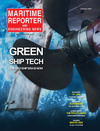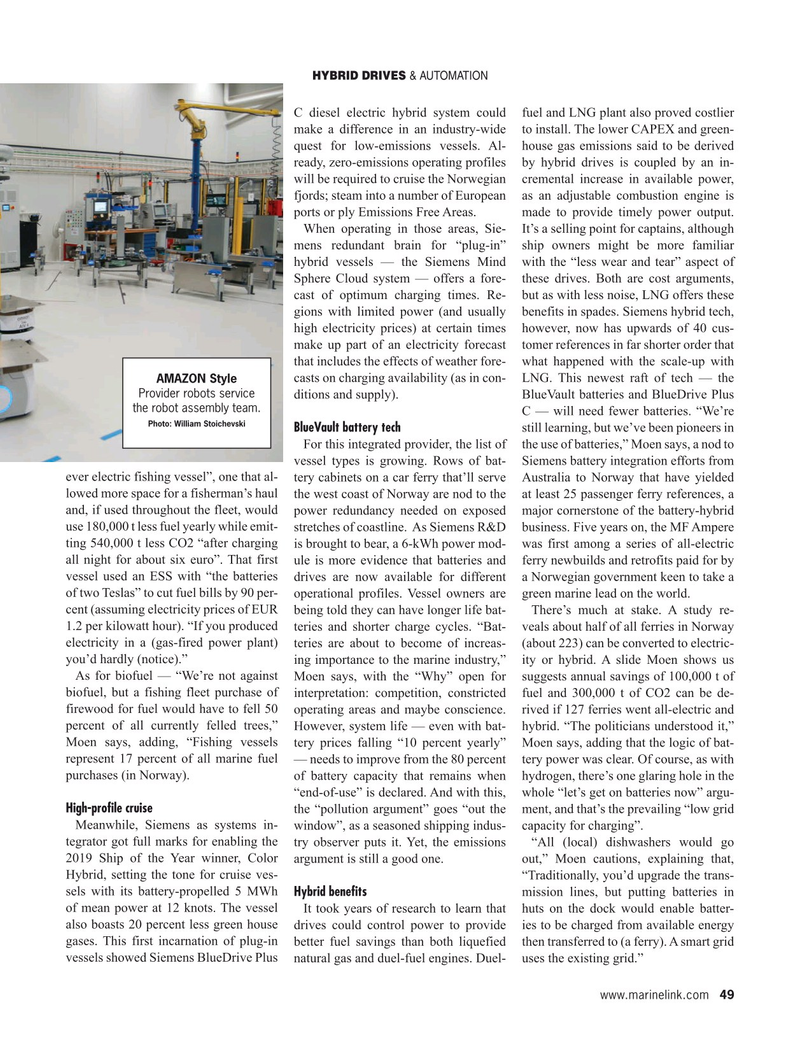
Page 49: of Maritime Reporter Magazine (February 2020)
Green Ship Technology
Read this page in Pdf, Flash or Html5 edition of February 2020 Maritime Reporter Magazine
HYBRID DRIVES & AUTOMATION
C diesel electric hybrid system could fuel and LNG plant also proved costlier make a difference in an industry-wide to install. The lower CAPEX and green- quest for low-emissions vessels. Al- house gas emissions said to be derived ready, zero-emissions operating profiles by hybrid drives is coupled by an in- will be required to cruise the Norwegian cremental increase in available power, fjords; steam into a number of European as an adjustable combustion engine is ports or ply Emissions Free Areas. made to provide timely power output.
When operating in those areas, Sie- It’s a selling point for captains, although mens redundant brain for “plug-in” ship owners might be more familiar hybrid vessels — the Siemens Mind with the “less wear and tear” aspect of
Sphere Cloud system — offers a fore- these drives. Both are cost arguments, cast of optimum charging times. Re- but as with less noise, LNG offers these gions with limited power (and usually benefits in spades. Siemens hybrid tech, high electricity prices) at certain times however, now has upwards of 40 cus- make up part of an electricity forecast tomer references in far shorter order that that includes the effects of weather fore- what happened with the scale-up with casts on charging availability (as in con- LNG. This newest raft of tech — the
AMAZON Style
Provider robots service ditions and supply). BlueVault batteries and BlueDrive Plus the robot assembly team.
C — will need fewer batteries. “We’re
Photo: William Stoichevski
BlueVault battery tech still learning, but we’ve been pioneers in
For this integrated provider, the list of the use of batteries,” Moen says, a nod to vessel types is growing. Rows of bat- Siemens battery integration efforts from ever electric fishing vessel”, one that al- tery cabinets on a car ferry that’ll serve Australia to Norway that have yielded lowed more space for a fisherman’s haul the west coast of Norway are nod to the at least 25 passenger ferry references, a and, if used throughout the fleet, would power redundancy needed on exposed major cornerstone of the battery-hybrid use 180,000 t less fuel yearly while emit- stretches of coastline. As Siemens R&D business. Five years on, the MF Ampere ting 540,000 t less CO2 “after charging is brought to bear, a 6-kWh power mod- was first among a series of all-electric all night for about six euro”. That first ule is more evidence that batteries and ferry newbuilds and retrofits paid for by vessel used an ESS with “the batteries drives are now available for different a Norwegian government keen to take a of two Teslas” to cut fuel bills by 90 per- operational profiles. Vessel owners are green marine lead on the world. cent (assuming electricity prices of EUR being told they can have longer life bat- There’s much at stake. A study re- 1.2 per kilowatt hour). “If you produced teries and shorter charge cycles. “Bat- veals about half of all ferries in Norway electricity in a (gas-fired power plant) teries are about to become of increas- (about 223) can be converted to electric- you’d hardly (notice).” ing importance to the marine industry,” ity or hybrid. A slide Moen shows us
As for biofuel — “We’re not against Moen says, with the “Why” open for suggests annual savings of 100,000 t of biofuel, but a fishing fleet purchase of interpretation: competition, constricted fuel and 300,000 t of CO2 can be de- firewood for fuel would have to fell 50 operating areas and maybe conscience. rived if 127 ferries went all-electric and percent of all currently felled trees,” However, system life — even with bat- hybrid. “The politicians understood it,”
Moen says, adding, “Fishing vessels tery prices falling “10 percent yearly” Moen says, adding that the logic of bat- represent 17 percent of all marine fuel — needs to improve from the 80 percent tery power was clear. Of course, as with purchases (in Norway). of battery capacity that remains when hydrogen, there’s one glaring hole in the “end-of-use” is declared. And with this, whole “let’s get on batteries now” argu-
High-profile cruise the “pollution argument” goes “out the ment, and that’s the prevailing “low grid
Meanwhile, Siemens as systems in- window”, as a seasoned shipping indus- capacity for charging”. tegrator got full marks for enabling the try observer puts it. Yet, the emissions “All (local) dishwashers would go 2019 Ship of the Year winner, Color argument is still a good one. out,” Moen cautions, explaining that,
Hybrid, setting the tone for cruise ves- “Traditionally, you’d upgrade the trans- sels with its battery-propelled 5 MWh Hybrid benefits mission lines, but putting batteries in of mean power at 12 knots. The vessel It took years of research to learn that huts on the dock would enable batter- also boasts 20 percent less green house drives could control power to provide ies to be charged from available energy gases. This first incarnation of plug-in better fuel savings than both liquefied then transferred to (a ferry). A smart grid vessels showed Siemens BlueDrive Plus natural gas and duel-fuel engines. Duel- uses the existing grid.” www.marinelink.com 49
MR #2 (34-49).indd 49 2/5/2020 11:46:02 AM

 48
48

 50
50
